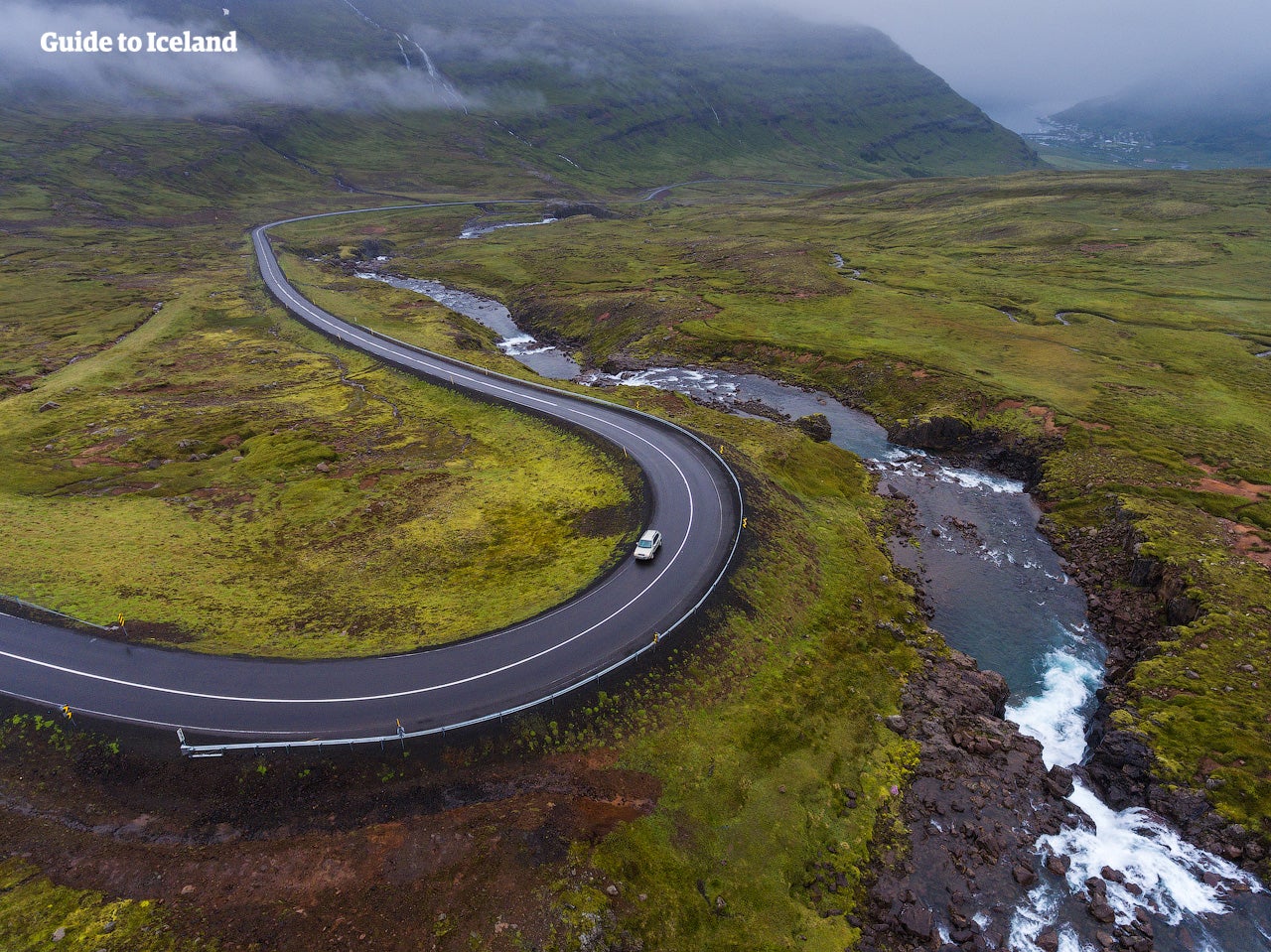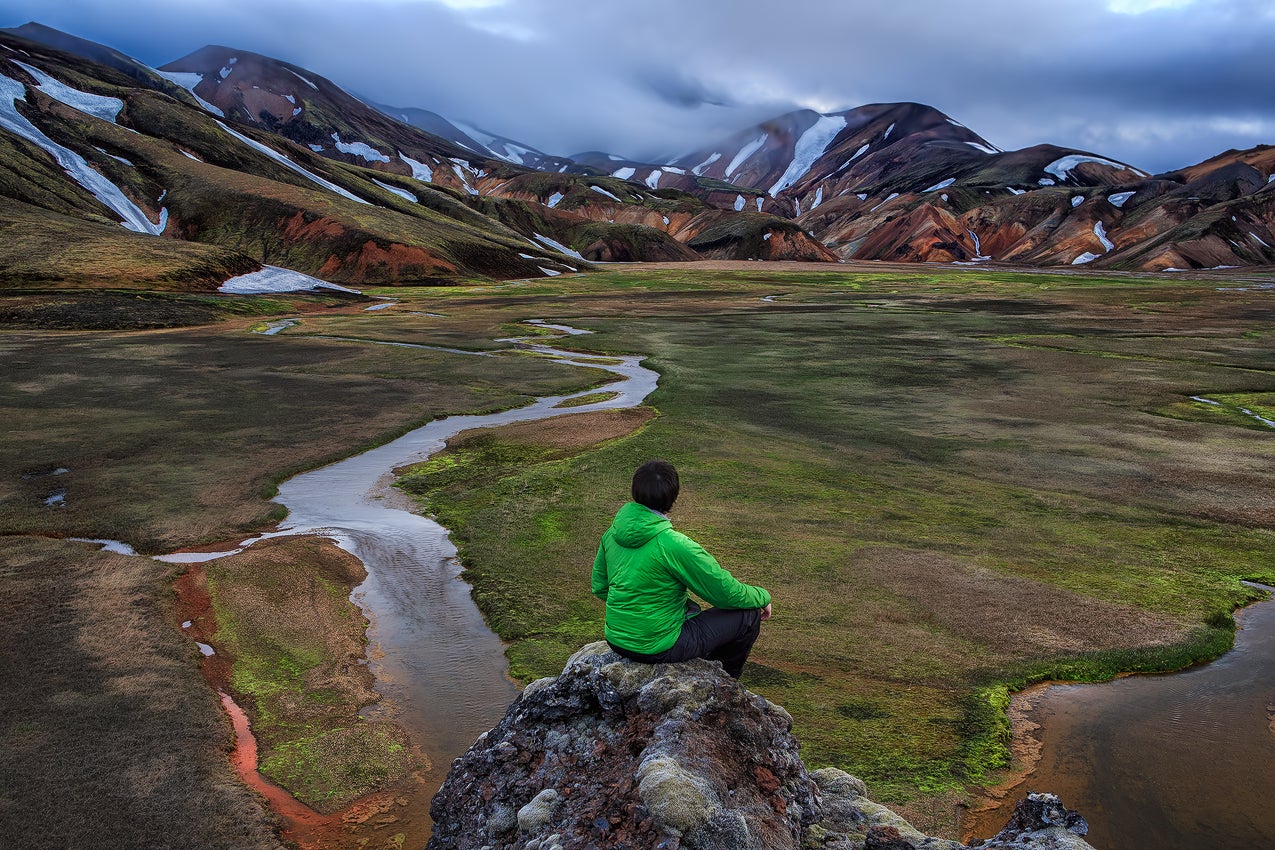
Plan your trip with ease and learn about the best transportation in Iceland to explore its glaciers, waterfalls, volcanoes, and coastal landscapes. Understanding your travel options makes it easier to enjoy the country’s top attractions without unnecessary stress.
Travelers can choose self-drive tours for flexibility, bus tours for guided sightseeing, and unique excursions like the tour inside the Thrihnukagigur Volcano from Reykjavik for a one-of-a-kind experience. These options let you tailor your journey based on your interests and preferred pace.
Why You Can Trust Our Content
Guide to Iceland is the most trusted travel platform in Iceland, helping millions of visitors each year. All our content is written and reviewed by local experts who are deeply familiar with Iceland. You can count on us for accurate, up-to-date, and trustworthy travel advice.
For smooth arrivals and departures, reliable airport transfers connect Keflavik International Airport with Reykjavik and other popular destinations, making it simple to get around. They provide comfort and convenience, especially for first-time visitors.
Keep reading to discover the best ways to travel across Iceland, compare your options, and plan an unforgettable journey.
Key Takeaways
The main modes of transportation in Iceland are rental cars, guided tours, buses, domestic flights, and taxis.
-
Driving in Iceland: Renting a car is the most popular option. Be aware of traffic rules, weather changes, and road conditions.
-
Guided tours: Many people also take guided tours for an easier transportation option that also allows them to take in the scenery.
-
Public transport: Staeto buses operate in Reykjavik and nearby areas, with payment options including the Klappid app and contactless card payments.
-
Domestic flights: Book flights across Iceland to reach remote locations, especially in winter.
-
Taxis and transfers: Airport taxi transfers to Reykjavik are available, but there's no Uber or Lyft in Iceland.
Explore Iceland via Breathtaking Tours
Transportation in Iceland is simple when you book tours. Whether you choose day tours, guided tour packages, or helicopter tours, each option includes convenient transport so you can explore without worrying about driving or planning routes.
Day Tours
 Day tours are a great way to see Iceland’s highlights in one day. Most tours include pickup and drop-off from Reykjavik, making them hassle-free.
Day tours are a great way to see Iceland’s highlights in one day. Most tours include pickup and drop-off from Reykjavik, making them hassle-free.
One of the most popular options is the Golden Circle tour, which covers:
-
Thingvellir National Park: Where the North American and Eurasian tectonic plates meet.
-
Gullfoss Waterfall: A stunning two-tiered cascade.
-
Geysir Geothermal Area: Home to the erupting Strokkur Geyser.
Other exciting day tours include:
-
Snaefellsnes National Park Small-Group Day Tour: See Iceland’s diverse landscapes in one trip.
-
The South Coast Tour From Reykjavik: Explore the Seljalandsfoss and Skogafoss waterfalls, Reynisfjara Black Sand Beach, and glacier viewpoints.
-
Crystal Blue Ice Cave Tour: Discover the magical blue ice caves beneath Vatnajokull Glacier, a unique experience available only in winter.
Day tours are ideal for travelers who want easy transportation and guided experiences in one package.
Adventurous Guided Day Tours
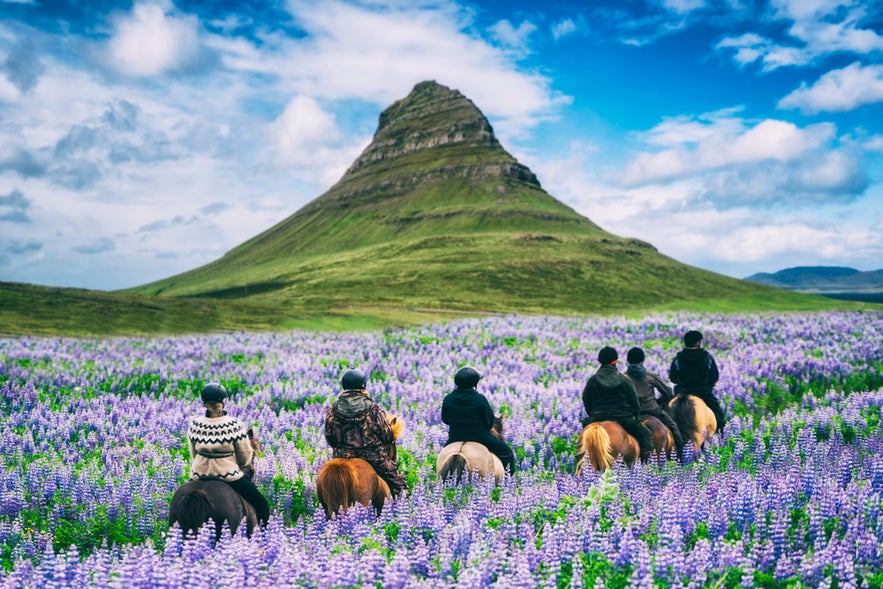 For longer trips, guided packages are the most convenient option. These tours include transportation, accommodation, and activities in a single booking. You’ll travel by buses, minibuses, or super jeeps, depending on the itinerary.
For longer trips, guided packages are the most convenient option. These tours include transportation, accommodation, and activities in a single booking. You’ll travel by buses, minibuses, or super jeeps, depending on the itinerary.
Many packages also feature exciting add-ons:
-
Horseback riding tours on Icelandic horses
-
Snorkeling experiences between continental plates
-
Volcano tours for an up-close look at Iceland’s geothermal power
With all transfers and lodging arranged, guided packages make exploring Iceland stress-free and efficient.
Helicopter Tours
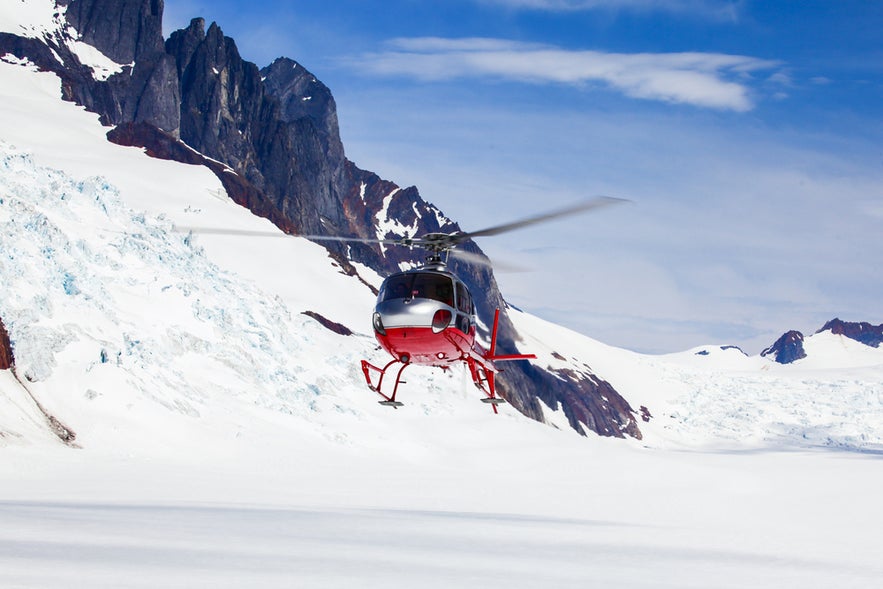 For a luxurious and cool means of transportation to take in Iceland’s dramatic scenery, helicopter tours offer breathtaking aerial views of Reykjavik, geothermal areas, and remote locations untouched by crowds. Some helicopter tours even land in secluded spots, giving you an exclusive experience in nature.
For a luxurious and cool means of transportation to take in Iceland’s dramatic scenery, helicopter tours offer breathtaking aerial views of Reykjavik, geothermal areas, and remote locations untouched by crowds. Some helicopter tours even land in secluded spots, giving you an exclusive experience in nature.
Traveling by Car

Renting a car in Iceland is the easiest and most common way to get around the country. To prepare for a road trip, we recommend checking out this guide to driving in Iceland for tips and traffic rules.
Iceland is an incredibly popular destination for those who enjoy self-drive tours. This is where your accommodation, itinerary, and activities are all taken care of, so when you arrive in Iceland, you just pick up a car from the airport and hit the road.
A benefit of choosing to drive around Iceland is that you will get to see so much of the country and gain a perspective of how the natural landscape in Iceland changes. It also means that you can travel at your own pace, which can be essential for families and Iceland solo travel.
-
Learn more about Things To Do and Places to Visit in Iceland
Enjoy Meet-on-Location Tours
 Driving also allows you to enjoy meet-on-location tours. A few of the most popular options include:
Driving also allows you to enjoy meet-on-location tours. A few of the most popular options include:
-
Jokulsarlon Boat Tour: Sail among towering icebergs at the stunning glacier lagoon in Southeast Iceland.
-
Glacier Hiking at Skaftafell: Explore Vatnajokull’s icy terrain with a guided hike in Southeast Iceland.
-
Katla Ice Cave Tour: Discover a stunning ice cave beneath the Katla Volcano on the South Coast.
-
Whale Watching in Husavik: Spot humpback whales, minke whales, and more on a boat tour in North Iceland.
-
Snorkeling in Silfra: Swim between tectonic plates in crystal-clear waters in Thingvellir.
-
Snowmobiling on Langjokull: Ride across Iceland’s second-largest glacier near Gullfoss.
-
The Blue Lagoon Comfort: Relax in the world-famous geothermal spa, surrounded by mineral-rich, milky-blue waters.
Enjoy Private Guided Tours
 If you prefer not to drive yourself, taking private guided tours in Iceland is an excellent alternative. This option allows you to relax and fully immerse yourself in the breathtaking scenery while a knowledgeable local guide navigates wintry roads. You can view the northern lights or customize your own tour across Iceland with the comfort of privacy and a skilled driver.
If you prefer not to drive yourself, taking private guided tours in Iceland is an excellent alternative. This option allows you to relax and fully immerse yourself in the breathtaking scenery while a knowledgeable local guide navigates wintry roads. You can view the northern lights or customize your own tour across Iceland with the comfort of privacy and a skilled driver.
Car Travel Tips
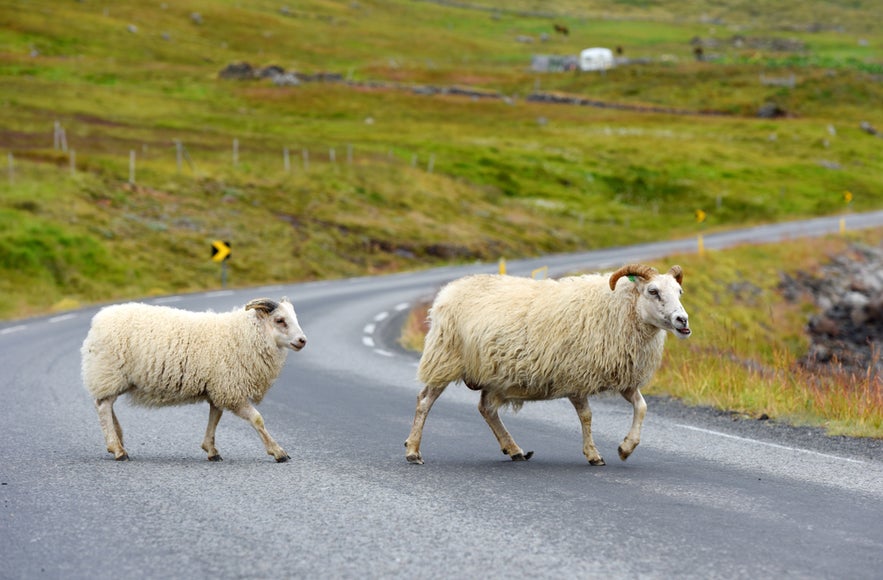 There is some important advice to remember when driving in Iceland, including:
There is some important advice to remember when driving in Iceland, including:
-
Speed limits: Max speed is 56 mph (90 km/h), so watch for signs and enforcement to avoid speeding in Iceland.
-
Weather changes: Conditions shift fast — sunny roads can turn icy. If visibility is poor, stop safely and wait it out.
-
Wind caution: Strong winds can damage car doors — open them carefully.
-
Sheep on roads: They roam freely — stay alert and never stop in the middle of the road for photos.
Carpooling
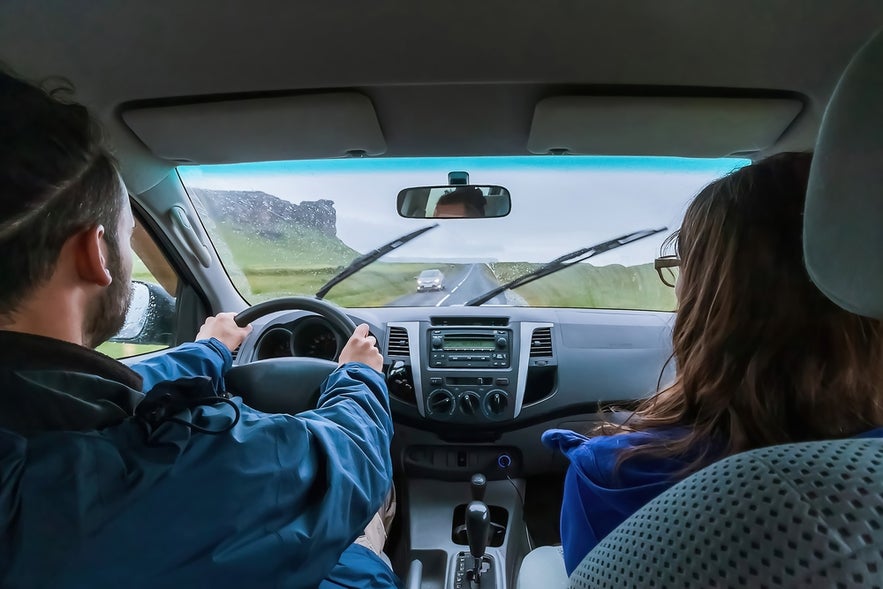 Carpooling is a budget-friendly way to reach remote destinations, especially since Iceland doesn’t have Uber or similar ride services.
Carpooling is a budget-friendly way to reach remote destinations, especially since Iceland doesn’t have Uber or similar ride services.
Samferda.net is a ride-sharing website where drivers post trips and available seats, allowing passengers to split fuel costs. Established in 2005, it’s an easy and affordable way to travel, with options to contact drivers for details. It is available in English and German.
Traveling by Bus

Bus services can be a good option for those who don't want to rent a car but want to see more of Iceland. However, this mode of transportation requires some preparation, depending on your desired itinerary, and has some limitations. Here's all you need to know about traveling by bus in Iceland.
Straeto Bus
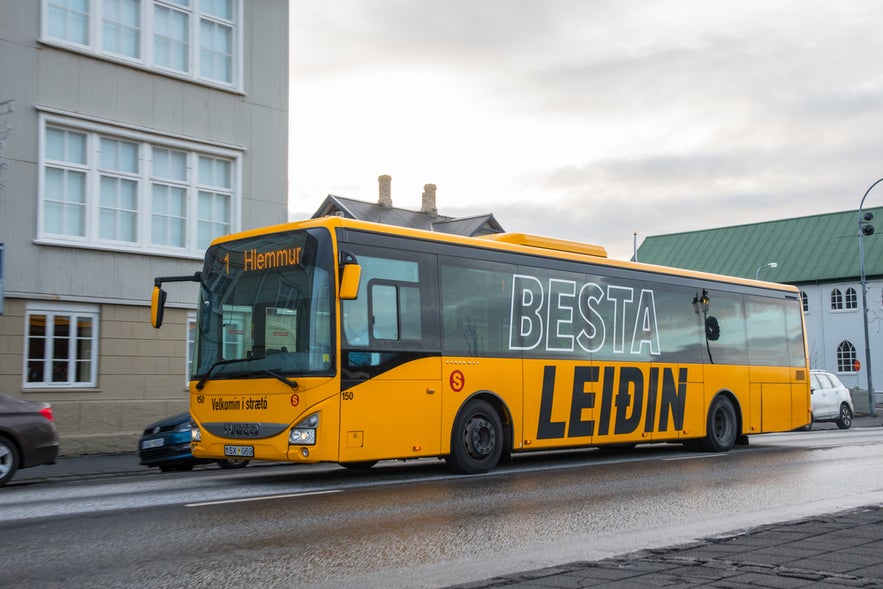 The only public transportation in Iceland is the Straeto bus service. This is run by the government and is a convenient way to get around Reykjavik and the surrounding areas. Official bus stops are found throughout the city, and all of them have the timetable and bus route available there.
The only public transportation in Iceland is the Straeto bus service. This is run by the government and is a convenient way to get around Reykjavik and the surrounding areas. Official bus stops are found throughout the city, and all of them have the timetable and bus route available there.
Staeto has an Iceland bus app called Klappid, which is available for iOS and Android. It is available in English and is an incredibly convenient way to purchase tickets and manage your public bus transportation in Iceland. Travelers can use the app or the Straeto website to plan routes by entering their location, destination, and desired departure or arrival time to see available bus options on a map.
If you don't want to get a card or download the app, you can also pay via contactless card transactions. You can find up to date price information on the Klappid website.
Day passes can be purchased at several retailers and are available for one to three days. You can find the complete list of places that sell bus passes on the city bus website.
Bus route 55 also operates between Reykjavik and Keflavik International Airport. The route works on timetables that reflect the flights coming in and out of Iceland.
Bus Routes Beyond Reykjavik
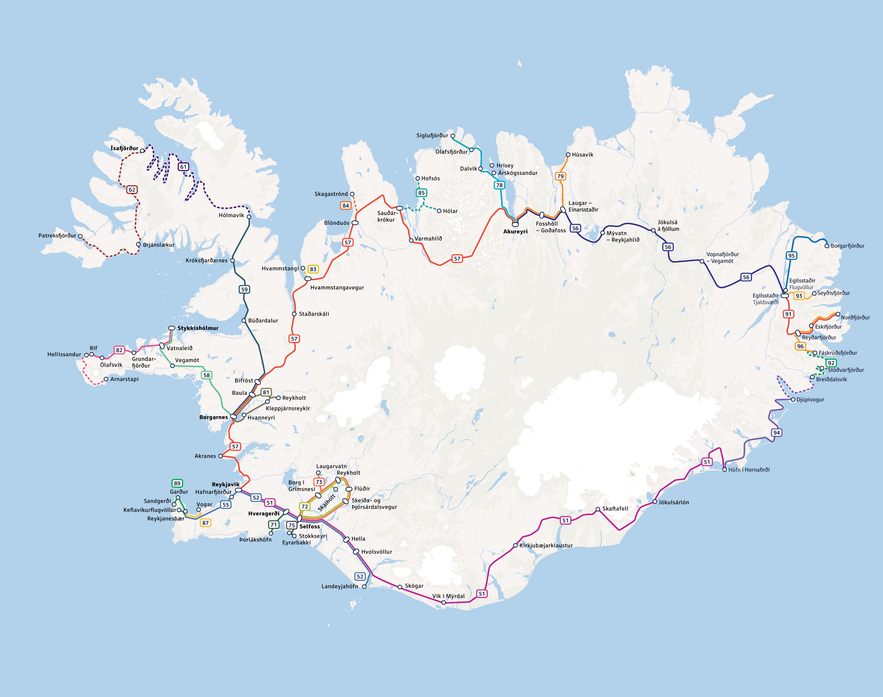
-
South Coast: Bus route 51 connects Reykjavik with the Jokulsarlon Glacier Lagoon and other South Coast destinations on weekdays, except Wednesdays.
-
North Iceland: Route 57 takes travelers between Akureyri and Reykjavik.
-
Other destinations: Travelers can reach the Snaefellsnes Peninsula and the Golden Circle by taking multiple bus routes.
Since public transportation is limited outside the capital region and Akureyri, it’s essential to plan and consider alternative transport options once arriving at a destination.
Highland Buses
Highland bus tours operate during the summer months, providing hikers with access to Iceland’s remote interior. These buses are essential for reaching areas such as the Landmannalaugar region, Thorsmork Valley, and Askja Volcano, which are otherwise inaccessible by regular vehicles.
These routes are often bumpy and require specially equipped buses to navigate the rugged terrain. Passengers should check schedules in advance, as routes may be affected by weather and road conditions.
Organized Bus Tours
For those looking for guided travel experiences, there are many organized bus tours to explore the country’s most stunning destinations. Some of their most popular tours include:
-
Golden Circle tours: Visit the famous Thingvellir National Park, Geysir Geothermal Area, and Gullfoss Waterfall.
-
South Coast tours: Explore black sand beaches, waterfalls like Seljalandsfoss and Skogafoss, and glaciers such as Solheimajokull.
-
Snaefellsnes Peninsula tours: Experience the diverse landscapes of Snaefellsnes, including Kirkjufell Mountain and lava fields.
-
Northern lights tours: Join an evening tour to hunt for the magical aurora borealis.
These tours are led by experienced guides who provide insights into Iceland’s history, geology, and culture.
Traveling by Plane
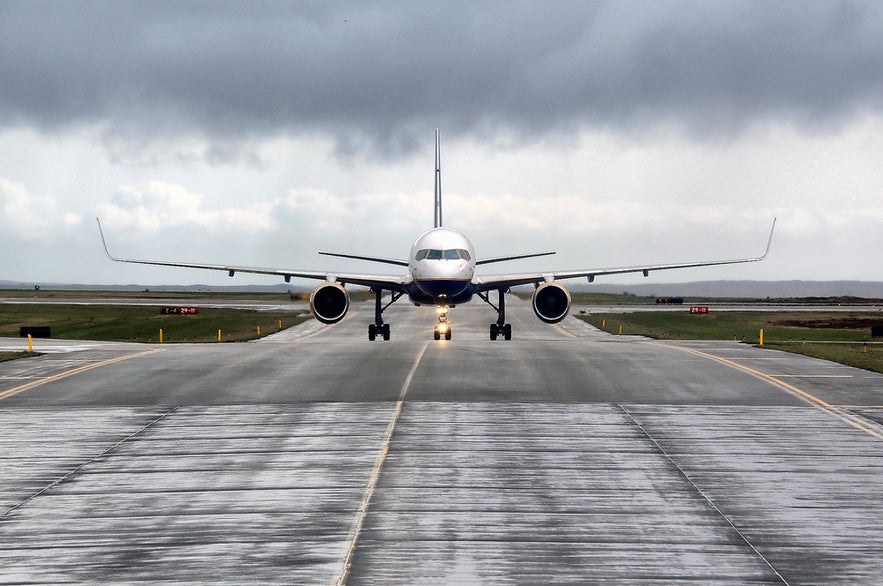 Iceland has one international airport, Keflavik Airport, situated on the Reykjanes Peninsula, approximately 31 miles (50 kilometers) outside Reykjavik city center. Iceland also has a network of domestic airports around the country, with regular daily flights to many of them.
Iceland has one international airport, Keflavik Airport, situated on the Reykjanes Peninsula, approximately 31 miles (50 kilometers) outside Reykjavik city center. Iceland also has a network of domestic airports around the country, with regular daily flights to many of them.
-
Learn more about Flights to Iceland.
Reykjavik Domestic Airport is located close to the center of the city and services flights to the North, East, West, and even Greenland and the Faroe Islands.
The majority of domestic flights within Iceland take less than an hour, meaning you could easily take flights from Reykjavik to Akureyri in the north if you are short on time.
Domestic flight services also provide access to some towns in Iceland during winter, when many roads to more remote places are closed.
The locations that are serviced by domestic flights throughout Iceland are:
-
Reykjavik (Southwest Iceland)
-
Keflavik (Southwest Iceland)
-
Grimsey (North Iceland)
-
Akureyri (North Iceland)
-
Egilsstadir (East Iceland)
-
Vopnafjorour (East Iceland)
-
Thorshofn (East Iceland)
-
Isafjordur (West Iceland)
-
Westman Islands (South Iceland)
-
Husavik (North Iceland)
-
Bildudalur (Westfjords)
-
Hornafjordur (Southeast Iceland)
-
Gjogur (Westfjords)
You can also arrange for private airport transportation in Iceland.
Traveling by Taxi
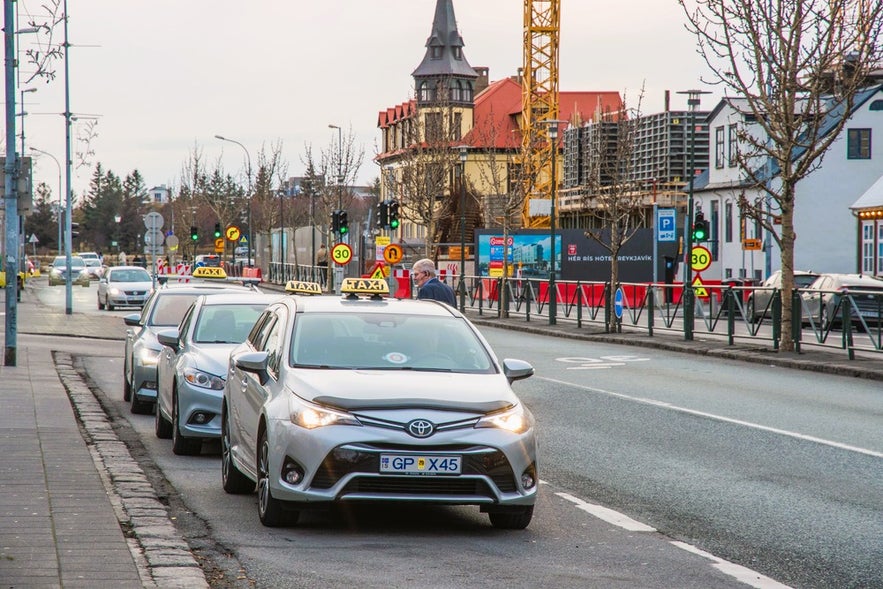 It's easy to get around Reykjavik by taxi, but it's expensive. Traveling by taxi can be convenient in downtown Reykjavík, although compared to other countries, the cost of a cab can be quite high. Taxis are located at cab ranks around the city. You can also call a taxi if you can’t find the cab rank or haven't had success hailing one.
It's easy to get around Reykjavik by taxi, but it's expensive. Traveling by taxi can be convenient in downtown Reykjavík, although compared to other countries, the cost of a cab can be quite high. Taxis are located at cab ranks around the city. You can also call a taxi if you can’t find the cab rank or haven't had success hailing one.
-
See also Nightlife in Reykjavik.
Taxis arrive pretty quickly in Iceland. Just like with bus drivers, most drivers speak English, but it’s not a requirement of their employment. Be prepared with translation tools to ensure communication runs smoothly.
There are two major taxi companies in Reykjavik, and they are Hreyfill and Taxi Reykjavik BSR:
-
To book through Hreyfill, call (354) 588-5522.
-
For Taxi Reykjavik BSR, call (354) 561-0000.
Hreyfill also has an Iceland taxi app available on the iPhone app store and Google Play.
There is no Uber or Lyft in Iceland yet. Although many locals would love to see these kinds of businesses come to Iceland, the legislation is not yet in favor of introducing them.
Hitchhiking
 Hitchhiking in Iceland is relatively safe due to the low crime rate and remains a common practice among budget travelers. However, it can be highly impractical, especially in remote areas where traffic is sparse. Many drivers on country roads are tourists, but locals occasionally pick up hitchhikers as well.
Hitchhiking in Iceland is relatively safe due to the low crime rate and remains a common practice among budget travelers. However, it can be highly impractical, especially in remote areas where traffic is sparse. Many drivers on country roads are tourists, but locals occasionally pick up hitchhikers as well.
Rapid weather changes make proper clothing essential, as standing in the cold and rain for hours can ruin your trip. While hitchhiking may save money, poor planning can leave travelers stranded, particularly in areas with limited road access.
As for safety, there haven’t been any major crime incidents involving hitchhikers in many years, but trust your instincts, and never enter a vehicle if you feel unsafe.
Also, camping is only allowed in designated camping areas. This is to prevent damage to the delicate environment so that it can be enjoyed for years to come. If you pitch a tent outside of a designated area, be prepared to face the consequences if discovered by authorities.
However, if you're near farmland, some farmers may allow hitchhikers to camp on their land if you ask politely. Keep in mind that this is not a reliable option, as not all farmers are open to it, so always have a backup plan.
-
Discover more in A Hitchhiker's Guide to Iceland.
Traveling by Boat
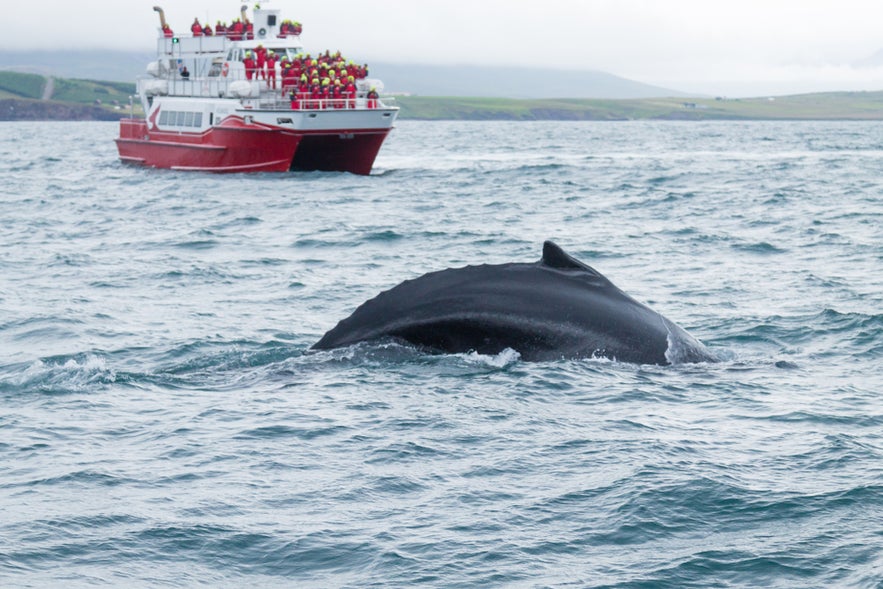 Taking a boat trip offers a unique perspective of Iceland, allowing you to experience the coastline from the sea. Whether you're spotting marine life on a whale-watching boat tour from Reykjavik or exploring glacial waters, boat tours provide unforgettable experiences.
Taking a boat trip offers a unique perspective of Iceland, allowing you to experience the coastline from the sea. Whether you're spotting marine life on a whale-watching boat tour from Reykjavik or exploring glacial waters, boat tours provide unforgettable experiences.
While Iceland itself sits just beneath the Arctic Circle, the northern island of Grimsey straddles this famous latitude. Accessible by boat from select towns in North Iceland, Grimsey is a popular day-trip destination where visitors can cross into the Arctic, get their passports stamped, and enjoy wildlife.
Beyond sightseeing, boats play a crucial role in transportation. Some remote regions and islands, particularly in winter, are only accessible by boat due to harsh weather and rugged terrain.
 For those traveling to Iceland by sea, ferries to Iceland offer a scenic and adventurous journey, connecting the country to mainland Europe. The Icelandic Road and Coastal Administration (IRCA) oversees several ferry routes integral to Iceland's transportation network.
For those traveling to Iceland by sea, ferries to Iceland offer a scenic and adventurous journey, connecting the country to mainland Europe. The Icelandic Road and Coastal Administration (IRCA) oversees several ferry routes integral to Iceland's transportation network.
These ferries connect various regions and islands, facilitating the movement of passengers and vehicles across the country.
Key Ferry Routes:
-
Vestmannaeyjar Archipelago - Landeyjahofn: The ferry Herjolfur operates multiple daily trips between the mainland and the Vestmannaeyjar (Westman Islands) archipelago, accommodating both passengers and vehicles.
-
Stykkisholmur - Flatey Island - Brjanslaekur: Baldur provides daily services on this route, transporting passengers and cars, with a stopover in Flatey (“Flat Island”) for passengers and cargo (excluding cars).
-
Arskogsstrond - Hrisey Island: The ferry Saevar offers daily sailings to Hrisey Island, carrying both passengers and cargo.
-
Hrisey Island - Dalvik - Grimsey: Saefari operates three times a week to Grimsey and twice weekly to Hrisey, serving passengers and cargo.
-
Neskaupstadur - Mjoifjordur Fjord: During winter, when roads are impassable, a ferry connects Neskaupstadur to the Mjoifjordur Fjord, ensuring transport of passengers and cargo.
These ferry services are considered extensions of the national road system and are subsidized by the IRCA. While the IRCA oversees these operations, the actual ferry services are outsourced to specialized companies.
Ferries travel to more remote parts of the country and some islands, like the Westman Islands. If you plan to book a car passage on a ferry, always reserve ahead.
-
Want to see the nature of the islands? Check out Westman Island tours.
You can also travel to Iceland by boat. There are regular ferries that travel to Iceland from both Denmark and England. These ferries land in the eastern Icelandic port of Seydisfjordur. It is possible to take a vehicle on these ferries. Several cruise ships also stop in Iceland.
Hiking
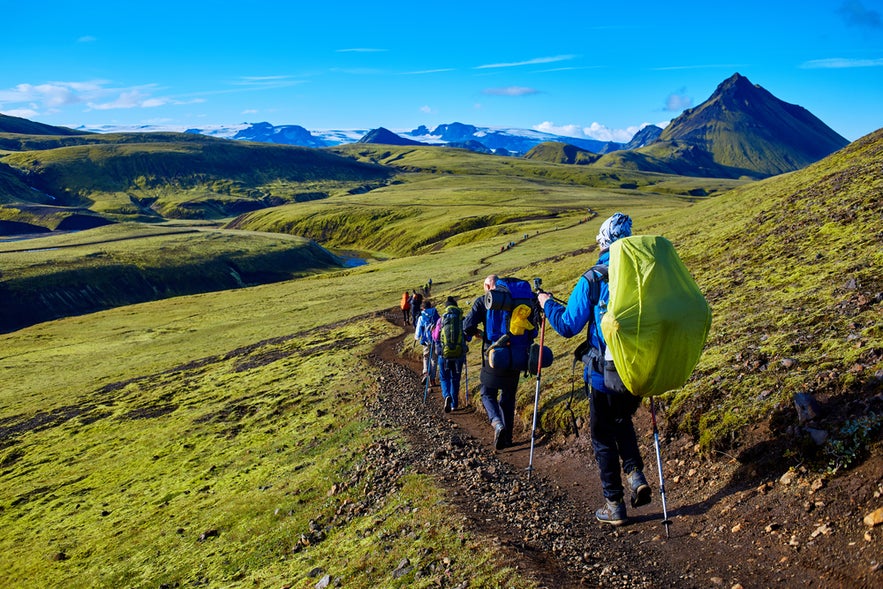 Hiking in Iceland offers a unique way to experience its stunning landscapes, with trails that take you where no car can. Options range from short, scenic walks to weeklong treks deep into nature.
Hiking in Iceland offers a unique way to experience its stunning landscapes, with trails that take you where no car can. Options range from short, scenic walks to weeklong treks deep into nature.
-
Best season: Summer is ideal, with long daylight hours and temperatures reaching 68°F (20°C). Winters can drop below 14°F (-10°C), making conditions harsh.
-
Essential gear: Weather changes fast — pack accordingly. A GPS and a map are crucial in the Highlands, even on marked trails. Hiking gear can be rented in Reykjavik.
-
Safety tips: Always inform someone of your route and expected return. Some multiday trails have free huts, but bring your own bedding and leave them as you found them.
-
Guided tours: For a safer, more immersive experience, consider joining guided hiking tours.
Traveling by Bike
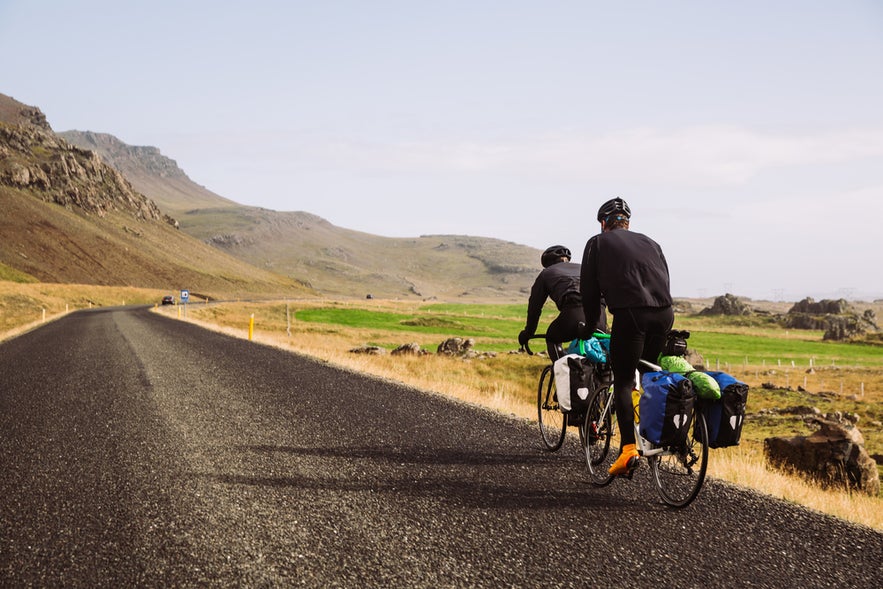 Biking in Iceland offers a unique and adventurous way to explore, from city tours in Reykjavik to adventurous mountain biking tours.
Biking in Iceland offers a unique and adventurous way to explore, from city tours in Reykjavik to adventurous mountain biking tours.
It may not be the first place you think of when considering a biking holiday, but in recent years, Iceland has become popular for those wanting a real cycling challenge. If you are experienced enough, biking around the country is a great way to discover the land of fire and ice.
If you choose to bike in Iceland, you will experience a multitude of weather conditions and some incredible natural beauty.
If you do decide that you want the challenge, know that preparation is everything. You will experience rain, wind, sandstorms, and lots of other changes in the weather. You should also make sure you know how to make minor repairs and try to have plans for just about any situation. If you are going to bike the Ring Road, it’s going to be much more comfortable and safe in summer, and it will probably take longer than you think.
A biking day tour is a great way to see Iceland without having to prepare for weeks on the road.
Bringing your bike to Iceland shouldn’t be too difficult. Most airlines will let you store your bike in the cargo hold for a fee if it is packed in a bike box. When you arrive in Iceland, there is a facility 328 feet (100 meters) outside of the arrivals exit where you can reassemble your bike.
If you want to rent a bike locally, it’s totally possible. You can also bring a bike with you if you travel here on the ferry from Denmark.
Check out the updated cycling trail map for routes and tips.
FAQs About Transportation in Iceland
Here are some of the most common questions surrounding transportation in Iceland.
What Is the Best Way To Get Around Iceland?
Most travelers in Iceland rent a car or do self-drive tours for flexibility, with a 4x4 vehicle recommended in winter or for Highland roads. Guided tours are a great alternative for stress-free exploration of major attractions.
Public transport is limited outside Reykjavik, and while campervans offer a budget-friendly option, domestic flights are rarely needed. Biking and hitchhiking are possible but challenging. Renting a car or joining a tour is the best way to experience Iceland.
What Is the Main Transportation in Iceland?
The most common mode of transportation for travelers is renting a car, as it provides the freedom to explore Iceland’s scenic landscapes at their own pace.
Do I Need To Rent a Car in Iceland?
Renting a car is the best option for flexibility, especially for remote road trips. However, guided tours and public transport work well for shorter stays in Reykjavik. For summer, a standard car is fine for main roads. In winter or for exploring the Highlands, a 4x4 is recommended.
Is It Safe To Drive in Iceland?
Yes, but road conditions can be challenging, especially in winter. Check road conditions and weather updates, and ensure you rent the proper vehicle for your travel plans.
Is Transport Expensive in Iceland?
Costs differ based on transportation method, but a single bus ticket in Reykjavik costs just under 5 USD.
Is There Public Transportation in Iceland?
Public buses (Staeto) operate in Reykjavik and some rural areas, but they are limited. Renting a car or booking tours is more convenient for most travelers.
Are There Taxis or Ride-share Services in Iceland?
Taxis are available but expensive. There are no Uber or Lyft services in Iceland.
Is Fuel Expensive in Iceland?
Yes, gas prices are high. Fuel stations are widely available, but in remote areas, it's best to fill up when possible.
Are There Domestic Flights in Iceland?
Yes, domestic flights connect Reykjavik with Akureyri, Isafjordur, and other remote areas.
Can I Cycle Around Iceland?
Cycling is possible, but Iceland’s weather, strong winds, and long distances make it challenging. It’s best for experienced cyclists or during the summer months.
Choosing the Best Way To Get Around Iceland
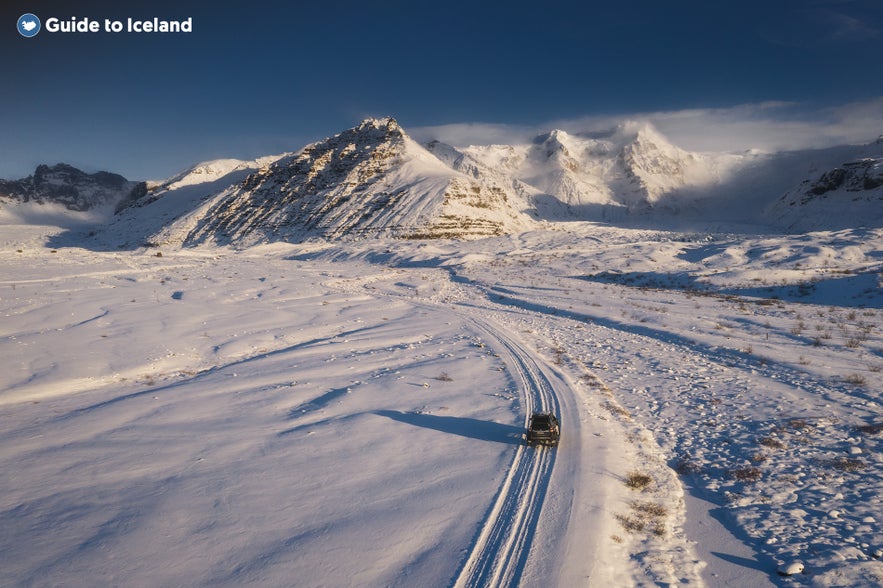 The best way to explore Iceland depends on your travel style and schedule. If you’re looking for flexibility, we recommend renting a car or campervan, with options like the 10-day Circle of Iceland self-drive for an unforgettable summer adventure. For a stress-free experience, consider guided tours such as the one-week guided winter Circle of Iceland tour, which provides expert insights and is perfect for exploring in colder months.
The best way to explore Iceland depends on your travel style and schedule. If you’re looking for flexibility, we recommend renting a car or campervan, with options like the 10-day Circle of Iceland self-drive for an unforgettable summer adventure. For a stress-free experience, consider guided tours such as the one-week guided winter Circle of Iceland tour, which provides expert insights and is perfect for exploring in colder months.
Day tours cover must-see spots like the Golden Circle and South Coast, while multi-day packages handle all logistics for a seamless trip. For a budget-friendly option, public buses and airport transfers make it easy to get around without a car.
No matter how you choose to travel, Iceland’s stunning scenery ensures an unforgettable adventure.
What’s your ideal way to see Iceland? Do you prefer the freedom of a road trip or the ease of a guided tour? Share your thoughts in the comments!



